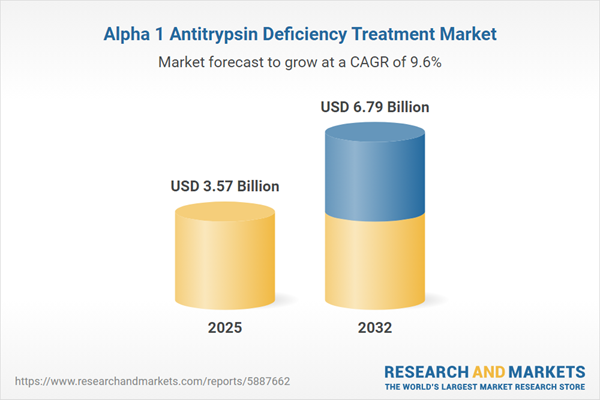Speak directly to the analyst to clarify any post sales queries you may have.
Senior decision-makers in the alpha 1 antitrypsin deficiency treatment market are facing transformative shifts shaped by digital advancement, evolving healthcare models, and a firm focus on patient-centered innovation. This market intelligence resource offers targeted insights to support executive planning and adaptive leadership in a dynamic pharmaceutical sector.
Market Snapshot: Alpha 1 Antitrypsin Deficiency Treatment Market Growth Outlook
The global alpha 1 antitrypsin deficiency treatment market is poised for significant expansion. Accelerated by advances in treatment modalities and robust investments from pharmaceutical organizations, the industry outlook remains positive. Market projections indicate expansion from USD 3.26 billion in 2024 to USD 3.57 billion in 2025, achieving a 9.62% compound annual growth rate (CAGR). By 2032, the market is anticipated to reach USD 6.79 billion. Key growth drivers include the adoption of gene therapy innovations, increased R&D from biotech and pharma sectors, and regulatory frameworks that foster rapid commercialization of new treatments. Executives must navigate an evolving competitive landscape, adapt strategies, and leverage collaborative partnerships to maintain strong market positioning.
Scope & Segmentation: Actionable Insights for Senior Leaders
This report provides senior leadership with comprehensive segmentation and industry drivers, enabling data-driven decision-making and portfolio growth. Insights span key segments, technology use, and regional trends.
- Therapy Class: Explores the impact of traditional augmentation therapies, the integration of gene therapies utilizing adeno-associated and lentiviral vectors, and advances in plasma infusion techniques which are opening new research avenues.
- Distribution Channel: Assesses trends across hospitals, online pharmacies, and retail, noting the rise of decentralized and digital distribution models that enhance patient access and engagement.
- Delivery Mode: Compares inhalation and intravenous therapies, highlighting their respective impacts on flexible care delivery and clinical infrastructure adaptation.
- End User: Identifies usage patterns in homecare, hospital, and specialty clinic settings, with emphasis on operational and clinical factors influencing decentralized care.
- Patient Age Group: Reviews tailored treatment approaches for adults, pediatric, and geriatric segments, emphasizing the need for age-appropriate clinical strategies and communication.
- Geography: Analyzes trends in the Americas, Europe, Middle East & Africa, and Asia-Pacific regions, drawing attention to regulatory diversity, demographic change, and healthcare infrastructure variations affecting market access.
- Key Companies: Features leading players such as Grifols S.A., CSL Behring GmbH, Takeda Pharmaceutical Company Limited, Kamada Pharmaceuticals, and Vertex Pharmaceuticals, outlining their partnership strategies and differentiated approaches to commercialization and market expansion.
Key Takeaways for Strategic Leadership
- Adopting gene-based and personalized therapies aligns with value-based healthcare, enabling more targeted clinical interventions and supporting differentiation in the market.
- Strengthening supply chain agility addresses procurement complexities and ensures partners can maintain reliable treatment delivery under shifting global conditions.
- Integrating digital health technologies, such as telemedicine and automated services, supports scalable remote care and enhances operational efficiency across care models.
- Keeping abreast of evolving regulatory frameworks helps sustain favorable reimbursement and manages risk in dynamic environments.
- Enhancing cross-sector R&D, licensing, and supply partnerships extends organizational reach and nurtures readiness for future industry changes.
- Fostering organizational adaptability underpins process efficiency and competitiveness amid continuous healthcare policy developments.
Tariff Impact on Supply Chain and Patient Access
Recent U.S. tariff policy changes require therapeutic suppliers to reassess and diversify their alpha 1 antitrypsin deficiency treatment market supply chains. Many organizations are strengthening domestic manufacturing and building local supplier relationships to secure therapy availability. Large organizations can rely on established distribution networks, while smaller firms are focused on expanding supplier bases to reduce trade risk and maintain steady patient access amid regulatory adjustments.
Methodology & Data Sources
Market findings are based on interviews with clinicians, regulators, payers, and patient representatives, combined with leading industry publications, regulatory documents, and proprietary analysis. This balanced approach ensures reliable, actionable guidance for executive strategies.
Why This Alpha 1 Antitrypsin Deficiency Treatment Market Report Matters
- Delivers essential insights on emerging therapies and shifting distribution models to support robust product and portfolio development.
- Equips executive leaders with up-to-date regulatory and technology intelligence for effective planning in a rapidly evolving sector.
- Identifies adaptive partnership frameworks and strategies for broadening market presence and addressing evolving stakeholder expectations.
Conclusion
This comprehensive analysis empowers senior decision-makers to respond effectively as patient-centered care and new technologies transform the alpha 1 antitrypsin deficiency treatment market landscape.
Additional Product Information:
- Purchase of this report includes 1 year online access with quarterly updates.
- This report can be updated on request. Please contact our Customer Experience team using the Ask a Question widget on our website.
Table of Contents
3. Executive Summary
4. Market Overview
7. Cumulative Impact of Artificial Intelligence 2025
Companies Mentioned
The companies profiled in this Alpha 1 Antitrypsin Deficiency Treatment market report include:- Grifols S.A.
- CSL Behring GmbH
- Takeda Pharmaceutical Company Limited
- Kamada Pharmaceuticals
- Vertex Pharmaceuticals
Table Information
| Report Attribute | Details |
|---|---|
| No. of Pages | 191 |
| Published | October 2025 |
| Forecast Period | 2025 - 2032 |
| Estimated Market Value ( USD | $ 3.57 Billion |
| Forecasted Market Value ( USD | $ 6.79 Billion |
| Compound Annual Growth Rate | 9.6% |
| Regions Covered | Global |
| No. of Companies Mentioned | 6 |









